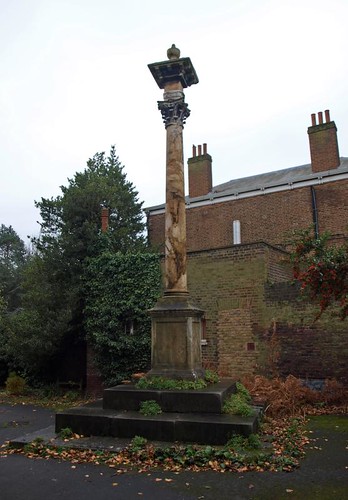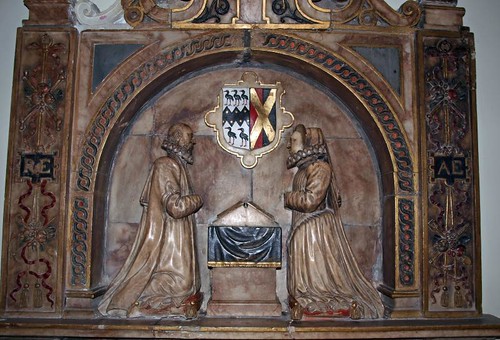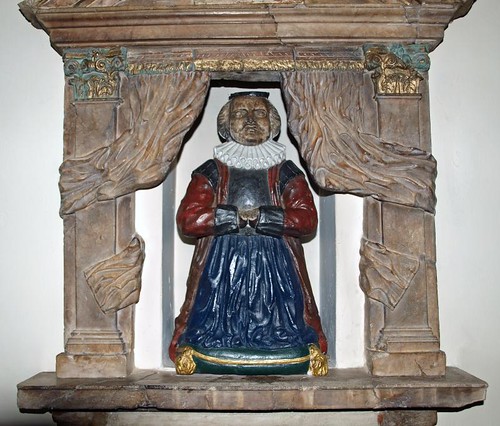ST MARY THE VIRGIN, High Road. Solid W tower of red brick, built in 1708. Arched and circular windows, short, polygonal pinnacles. The body of the church is by Charles Begon. Built in 1817, also red brick, with lancet windows. Nave and aisles. Thin piers and thin arcades. Recessed N and S galleries. Minor monuments, e.g. Rowland Elvington d. 1595 and wife, small, with the usual two kneelers. Also Charles Foulis of 1783, by J. Bacon. Urn on pedestal on which in relief a seated woman holding an oil lamp. In the churchyard tall Corinthian column with entablature, a memorial to Peter Godfrey d. 1742, designed by Sir Robert Taylor, whose early benefactor Peter Godfrey was. - Raikes Mausotaum. First interment Mrs William Raikes d. 1797. Heavy neo-classical. - Edward Keeble d. 1782 by S. Robinson, made of Coade stone; sarcophagus with angels at the corner; damaged (R. Gunnis).
WOODFORD. We come to it by one of the most impressive roads near London, a mile of trees marching with the highway from Wanstead. Around its approach are remnants of the great Essex Forest and beyond it the still delightful glades of Epping. It has memories of a lost church; it has known great days as a fashionable watering place; it has beyond Woodford Bridge the garden city of the older boys of Dr Barnardo’s homes; but it has passed through the changes that come to any place into which population flows by tens of thousands. In the changing present it will forget its past.
Yet some associations Woodford is not likely to forget, for it was the scene of the boyhood of William Morris, it was the birthplace of Sydney Smith and Coventry Patmore, and in its earth there lies one of the first and best of our ambassadors, Sir Thomas Roe. Strange it is that he should lie with no memorial.
One memorial there is in the churchyard, a draped urn which must bring many pilgrims to the grave it marks, for in it lie the father and the mother of William Morris. In this grave they laid his father in 1847 and nearly half a century later they laid the widow beside him. Here at Woodford Hall, within an arrow’s flight of the spot where his parents rest together, the poet passed the most sensitive years of his youth.
The father was a wealthy bill-broker in the City. The boy was born near by at Walthamstow, over the ridge which parts the Lea and Roding rivers, and when he was six they came to live at Woodford Hall. The park was separated only by a fence from the Forest, and the hall had a doorway into the churchyard. By the roadside, on a green space now enclosed, stood the village pound and stocks. Fifty years later Morris wrote of the Epping Forest he loved, “I was born and bred in its neighbourhood and knew it, yard by yard, from Wanstead to the Theydons and from Hale End to Fairlop Oak.” His life centred elsewhere in later years, but here it was that he received his primal impulses.
The old church has given place to a new one. A tombstone preserves the memory of a man who fell from the tower when it was being built in 1708, but the tower is the only part as early as that date. All the rest is modern, yet the list of rectors comes from 1177. The churchyard has a yew tree 17 feet round, still strong and healthy after its 400 years and more.
There is a beautiful wall-monument of Rowland Elrington and his wife, kneeling in Tudor dress under an arched recess, and a tall urn-capped column in memory of the Godfrey family, whose most famous member, Sir Edmund, was a magistrate of the highest repute, honest, public-minded, and generous, yet was murdered in connection with the so-called Popish Plot of the infamous Titus Oates, the mystery of his fate being one of the strangest chapters in the history of crime.
From the chancel arch hangs a flag which has been here since the Territorials came into being and which had been before them the flag of the Woodford Company of Volunteers raised to meet Napoleon if he came. A bright window with figures of Peace and Victory is in memory of the men who did not come back, and there are two windows in memory of two scouts among them, one showing David and Jonathan for Arthur Quelhorst, the other showing St Michael and St Denis in memory of Charles Eastgate. Of its witty dean and its sentimental poet Woodford has small remembrance; and of Sir Thomas Roe it had none that we could discover.
Sydney Smith won social fame as a brilliant talker until he became too much of a professional in that vein. A very hearty man and “good fellow,” he was too free in expressing his opinion to attain high dignity in the church, but his writings remain breezy even when their themes have become out-of-date. Coventry Patmore was a sentimentalist who won a public of his own by his simple style, and then bewildered his customary readers by exercises in more complex forms of expression. His general tone was feminine. A greater man than either of these two sons of Woodford was Sir Thomas Roe, one of the most successful ambassadors England ever sent to a foreign land.
He came of the London merchant class, his grandfather being a lord mayor. His education was by travel, though he went to Oxford and also had legal studies. When Queen Elizabeth was old he was a young squire at her Court, and James the First knighted him, while the Prince of Wales sent him more than once to explore the great South American rivers. His first experience as an ambassador was to the Mogul Emperor of Hindustan, to open up trade, and he succeeded in laying trade foundations in the Bombay region. On his way home he made a successful call in Persia and introduced England there.
After that his journeys abroad were frequent. First he went as ambassador to Turkey, and was so successful that he was kept at Constantinople against his own wishes for seven years. While there he negotiated a peace treaty between Turkey and Poland and liberated hundreds of English captives from Algerian pirates, secured the famous Codex Alexandrinus copy of the Bible now in the British Museum, and collected 29 manuscripts for the Bodleian. His next mission was to mediate on peace between Sweden and Poland, and he was successful in arranging a truce. On his way home he made trade treaties with Danzig and Denmark. James had a gold medal struck in his honour. Again he was sent abroad as the English Ambassador Extraordinary to a conference for settling a general European Peace, and similar visits continued until his death in 1644.
His intervals at home were occupied in Parliamentary work, he representing the University of Oxford. The charm of his manner and conversation was admitted wherever his duty carried him. In short, at that early period England had in Sir Thomas Roe an ideal ambassador with a European reputation, but there is no advertisement in such work, and so this successful worker for peace and helpful trade lies still without a monument in the place where he lies.
Yet some associations Woodford is not likely to forget, for it was the scene of the boyhood of William Morris, it was the birthplace of Sydney Smith and Coventry Patmore, and in its earth there lies one of the first and best of our ambassadors, Sir Thomas Roe. Strange it is that he should lie with no memorial.
One memorial there is in the churchyard, a draped urn which must bring many pilgrims to the grave it marks, for in it lie the father and the mother of William Morris. In this grave they laid his father in 1847 and nearly half a century later they laid the widow beside him. Here at Woodford Hall, within an arrow’s flight of the spot where his parents rest together, the poet passed the most sensitive years of his youth.
The father was a wealthy bill-broker in the City. The boy was born near by at Walthamstow, over the ridge which parts the Lea and Roding rivers, and when he was six they came to live at Woodford Hall. The park was separated only by a fence from the Forest, and the hall had a doorway into the churchyard. By the roadside, on a green space now enclosed, stood the village pound and stocks. Fifty years later Morris wrote of the Epping Forest he loved, “I was born and bred in its neighbourhood and knew it, yard by yard, from Wanstead to the Theydons and from Hale End to Fairlop Oak.” His life centred elsewhere in later years, but here it was that he received his primal impulses.
The old church has given place to a new one. A tombstone preserves the memory of a man who fell from the tower when it was being built in 1708, but the tower is the only part as early as that date. All the rest is modern, yet the list of rectors comes from 1177. The churchyard has a yew tree 17 feet round, still strong and healthy after its 400 years and more.
There is a beautiful wall-monument of Rowland Elrington and his wife, kneeling in Tudor dress under an arched recess, and a tall urn-capped column in memory of the Godfrey family, whose most famous member, Sir Edmund, was a magistrate of the highest repute, honest, public-minded, and generous, yet was murdered in connection with the so-called Popish Plot of the infamous Titus Oates, the mystery of his fate being one of the strangest chapters in the history of crime.
From the chancel arch hangs a flag which has been here since the Territorials came into being and which had been before them the flag of the Woodford Company of Volunteers raised to meet Napoleon if he came. A bright window with figures of Peace and Victory is in memory of the men who did not come back, and there are two windows in memory of two scouts among them, one showing David and Jonathan for Arthur Quelhorst, the other showing St Michael and St Denis in memory of Charles Eastgate. Of its witty dean and its sentimental poet Woodford has small remembrance; and of Sir Thomas Roe it had none that we could discover.
Sydney Smith won social fame as a brilliant talker until he became too much of a professional in that vein. A very hearty man and “good fellow,” he was too free in expressing his opinion to attain high dignity in the church, but his writings remain breezy even when their themes have become out-of-date. Coventry Patmore was a sentimentalist who won a public of his own by his simple style, and then bewildered his customary readers by exercises in more complex forms of expression. His general tone was feminine. A greater man than either of these two sons of Woodford was Sir Thomas Roe, one of the most successful ambassadors England ever sent to a foreign land.
He came of the London merchant class, his grandfather being a lord mayor. His education was by travel, though he went to Oxford and also had legal studies. When Queen Elizabeth was old he was a young squire at her Court, and James the First knighted him, while the Prince of Wales sent him more than once to explore the great South American rivers. His first experience as an ambassador was to the Mogul Emperor of Hindustan, to open up trade, and he succeeded in laying trade foundations in the Bombay region. On his way home he made a successful call in Persia and introduced England there.
After that his journeys abroad were frequent. First he went as ambassador to Turkey, and was so successful that he was kept at Constantinople against his own wishes for seven years. While there he negotiated a peace treaty between Turkey and Poland and liberated hundreds of English captives from Algerian pirates, secured the famous Codex Alexandrinus copy of the Bible now in the British Museum, and collected 29 manuscripts for the Bodleian. His next mission was to mediate on peace between Sweden and Poland, and he was successful in arranging a truce. On his way home he made trade treaties with Danzig and Denmark. James had a gold medal struck in his honour. Again he was sent abroad as the English Ambassador Extraordinary to a conference for settling a general European Peace, and similar visits continued until his death in 1644.
His intervals at home were occupied in Parliamentary work, he representing the University of Oxford. The charm of his manner and conversation was admitted wherever his duty carried him. In short, at that early period England had in Sir Thomas Roe an ideal ambassador with a European reputation, but there is no advertisement in such work, and so this successful worker for peace and helpful trade lies still without a monument in the place where he lies.



No comments:
Post a Comment